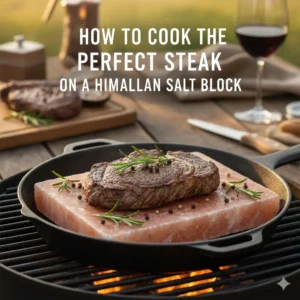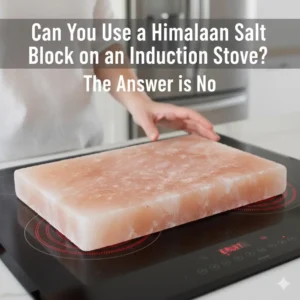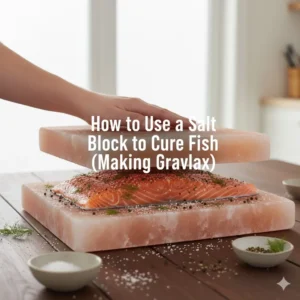Cooking on a Himalayan salt block is a culinary method that uses the block’s natural mineral content to season food while adding striking visual appeal. For chefs and food professionals, it delivers precise flavor control and a unique presentation that enhances both taste and experience. This article explains how salt transfer works and offers proven techniques to manage temperature, moisture, and timing—ensuring perfectly balanced results every time.

Prerequisites: Essential Tools & Materials for Salt Block Cooking
Preparing for salt block cooking requires a few dependable tools to ensure precision, safety, and consistent results. The right setup helps manage heat distribution, control moisture, and make handling effortless so your food sears evenly without absorbing too much salt. Gather the following essentials before heating your Himalayan salt block:
- High-quality Himalayan salt block (authentic pink salt from the Khewra region recommended).
- Stable, heat-safe cooking base, such as a grill or stovetop diffuser.
- Heat-resistant tongs or a sturdy spatula for safe food handling.
- Kitchen timer or clock to monitor cooking times accurately.
- Soft brush and clean cloth for gentle cleaning and drying after use.
Step-by-Step Guide to Controlling Saltiness in Salt Block Cooking
Step 1: Heat the Salt Block Gradually
Proper heating is the foundation of successful salt block cooking. Begin on low heat, allowing the block to warm slowly, and increase to medium and high over at least forty-five minutes. This gradual process drives out internal moisture, prevents cracking, and stabilizes the rate of salt release during cooking—producing consistent, even seasoning instead of sudden bursts of saltiness.
Maintain steady temperature control with a stovetop diffuser or indirect grill heat. Avoid placing the block directly in the oven, as uneven hot spots can stress and fracture the crystal structure.
Step 2: Work with Dry, Lightly Seasoned Ingredients
Moisture governs how salt transfers to food. The wetter the ingredient, the more salt it absorbs. Pat ingredients completely dry before cooking to limit surface moisture. Avoid heavy marinades or any pre-salting, since the salt block naturally seasons food as soon as moisture makes contact with it.
Focus on quick-cooking items like thin fish fillets, shrimp, or sliced vegetables. These sear evenly without staying on the block long enough to absorb excess salt.
Step 3: Cook Quickly and Space Items Out
A properly heated salt block functions as a high-temperature searing surface, not a slow-cooking grill pan. Sear foods just long enough to develop a golden crust and light salt flavor. Extended cooking increases salt absorption and can toughen textures.
Use small portions and leave gaps between pieces to allow even heat circulation. Overcrowding traps steam, lowers surface temperature, and causes uneven cooking with unpredictable salt levels.
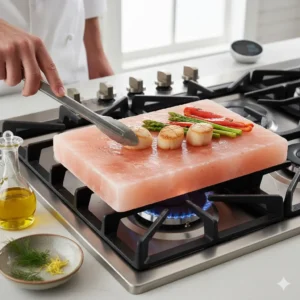
Step 4: Clean and Dry the Salt Block Thoroughly
After cooking, let the block cool to room temperature before cleaning. Gently brush away food residue without scraping or using detergents. If necessary, rinse lightly with minimal water, then dry completely in a well-ventilated area.
Store the cooled block wrapped in a clean towel or cloth to prevent moisture absorption. Proper cleaning preserves the block’s shape, prevents cracking, and maintains even salt release over time.
Step 5: Use the Salt Block for Quick-Cooking or Finishing
Salt blocks perform best with foods that cook quickly at high heat or those served cold. Avoid thick cuts or roasts—extended cooking leads to uneven heat dispersion and excess salt accumulation. Instead, use the block for items that benefit from a brief, high-temperature sear.
For larger cuts, try a hybrid method: cook them by another technique such as sous vide, then finish briefly on the salt block. This approach delivers a crisp exterior with precise control over both salt intensity and texture.
Watch a demonstration here: Salt Block Cooking Tutorial.
Premium Himalayan Salt Blocks for Culinary and Hospitality Needs
Partner with Jilin Ever Creation to source authentic pink Himalayan salt products from the Khewra Salt Mine. Our FDA- and EU-certified salt blocks provide versatile options for grilling, searing, and presentation, fully customizable to fit your brand’s specifications. With flexible minimum order quantities and global shipping, elevate your menu or product line with natural, mineral-rich salt blocks today.
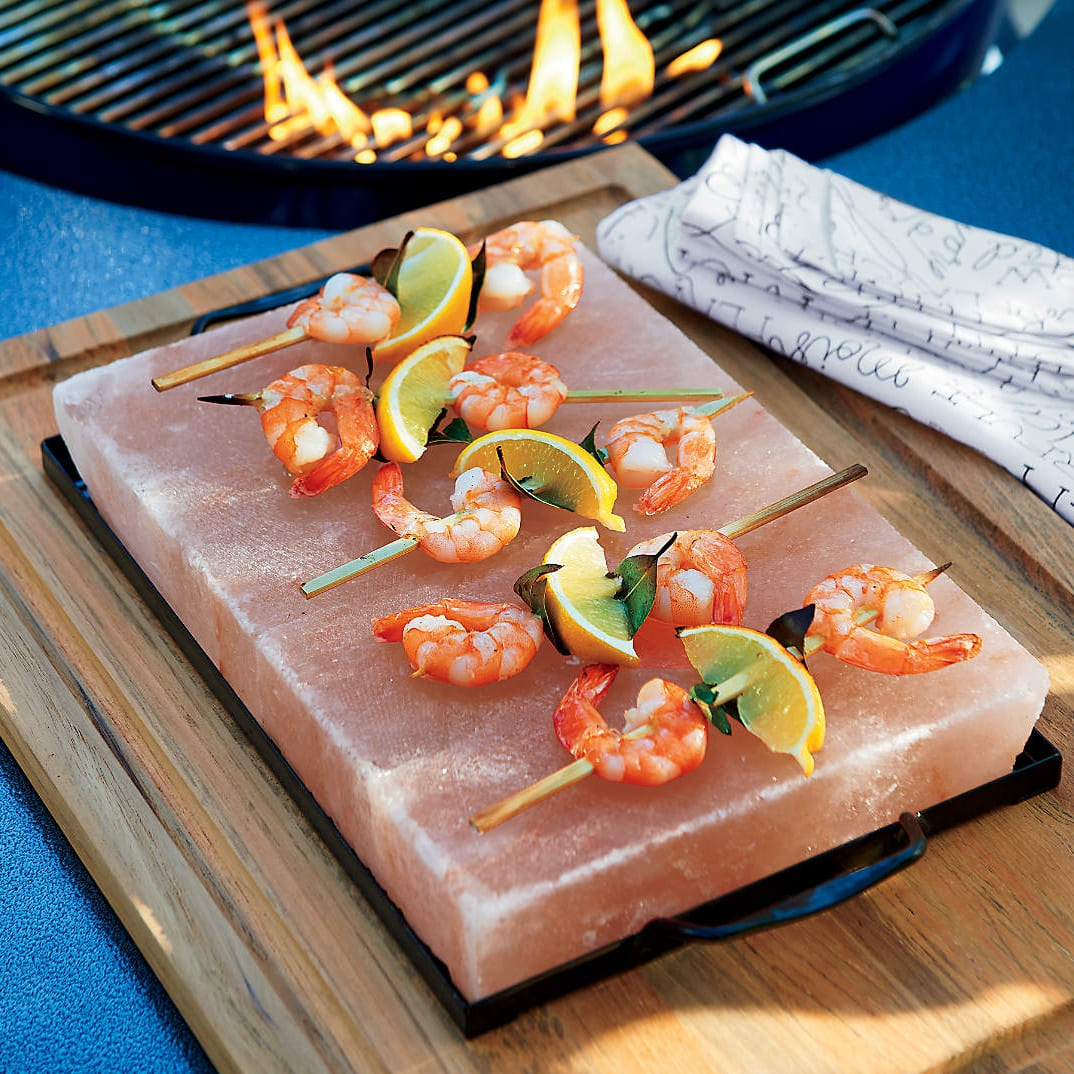
How Salt Transfer Influences Flavor Perception
Salt absorption on a cooking block depends primarily on contact time and moisture. Moist or fatty foods dissolve the salt surface more readily, increasing sodium uptake. In contrast, drier ingredients absorb less, giving the cook tighter control over seasoning intensity.
Temperature further refines this balance. A hotter block reduces contact time, allowing quick searing that locks in flavor without creating an over-salted exterior. Managing the interplay of time, heat, and moisture ensures precise texture and clean flavor rather than excess salinity.
From a sensory standpoint, taste buds detect sodium through epithelial sodium channels that rapidly adapt to salt levels. Even slight shifts in salinity can noticeably alter perceived flavor. Recognizing that sensitivity helps refine technique—adjusting surface temperature or moisture exposure maintains seasoning that feels balanced, natural, and deliberate.
Common Mistakes and How to Avoid Over-Salting Food
Many home cooks notice their first salt block dishes taste overly salty. The issue often lies in how time, moisture, and temperature interact on the surface. When the block is too cool or the food holds excess moisture, salt transfers unevenly and overwhelms the flavor. With careful adjustments to technique, you can control seasoning and achieve a balanced, natural taste.
The key factors are contact time and moisture management. Hotter blocks sear faster and release less salt, while dry ingredients prevent the surface from dissolving too quickly. By understanding these relationships, you can produce consistent results with clean, precise seasoning rather than unpredictable saltiness.
| Common Mistake | How to Avoid / Solution |
|---|---|
| Cooking on a block that isn’t hot enough | Preheat the salt block gradually to a high temperature before cooking. Proper heating minimizes excessive salt transfer and ensures an even sear. |
| Using wet or heavily marinated ingredients | Pat ingredients completely dry and avoid pre-salting or heavy marinades, which accelerate salt dissolution and create a harsh taste. |
| Letting food sit too long on the salt block | Cook briefly and remove the food once it’s seared to prevent excessive salt absorption and preserve its natural texture. |
| Cooking on a salt block still damp from cleaning | Allow the block to dry completely after cleaning to prevent steam buildup and surface cracking during reheating. |
| Using a salt block for long-cooking or thick items | Limit use to quick-cooking, thinner cuts or delicate items. For thicker proteins, use a hybrid cooking method or finish briefly on the block for flavor. |
Mastering control over heat, moisture, and timing turns salt block cooking from an uncertain experiment into a dependable technique. With practice, each dish captures the mineral depth of the salt while keeping every ingredient’s character intact.
Frequently Asked Questions
Does a hotter salt block make food more or less salty?
Hotter blocks usually yield less salt transfer because the food sears quickly, limiting moisture contact. The shorter contact time creates a crisp crust with balanced seasoning instead of an overly salty surface. Conversely, cooler blocks allow more moisture to dissolve salt, resulting in saltier food.
How does food moisture influence salt absorption from the block?
Moist foods draw out more salt because water dissolves the salt surface and accelerates absorption. Dry ingredients or those brushed lightly with oil absorb much less salt. Managing surface moisture before cooking helps maintain balanced flavor.
Should I rinse food after cooking on a salt block to reduce saltiness?
No. Rinsing removes the flavorful crust and desirable texture. To reduce saltiness, shorten contact time or minimize moisture before cooking. Blotting the surface gently with a paper towel after searing works better than rinsing.
Which foods are most prone to becoming too salty on a salt block?
High-moisture foods like tomatoes, shrimp, or thin fish fillets absorb salt quickly. Denser or fattier cuts, such as steak or duck, are easier to control because they form a quick surface barrier during searing. Choosing firm, quick-cooking items helps avoid excessive salt uptake.
Does the salt block become stronger or milder in flavor over time?
The block doesn’t become saltier with use; it gradually loses surface salt and stabilizes. A seasoned block actually imparts a more even and moderate flavor over time. Consistent cleaning and thorough drying prolong its life and help keep salt transfer steady.
Final Thoughts
Cooking with a salt block requires attention to time, temperature, and moisture. Heating the block gradually prevents cracks and ensures consistent salt release, while starting with dry ingredients keeps seasoning levels balanced. Using quick-cooking foods helps maintain natural flavor without risking oversalting.
Because salt transfer slows on a hot, dry surface, understanding how heat and moisture interact allows precise flavor control. Adjusting these factors lets you decide whether a dish should carry a subtle salt accent or a more pronounced mineral note.
With regular maintenance, patience, and experimentation, anyone can develop skill and confidence in salt block cooking. Over time, the technique shifts from trial and error to a refined approach that consistently delivers balanced, flavorful results.


